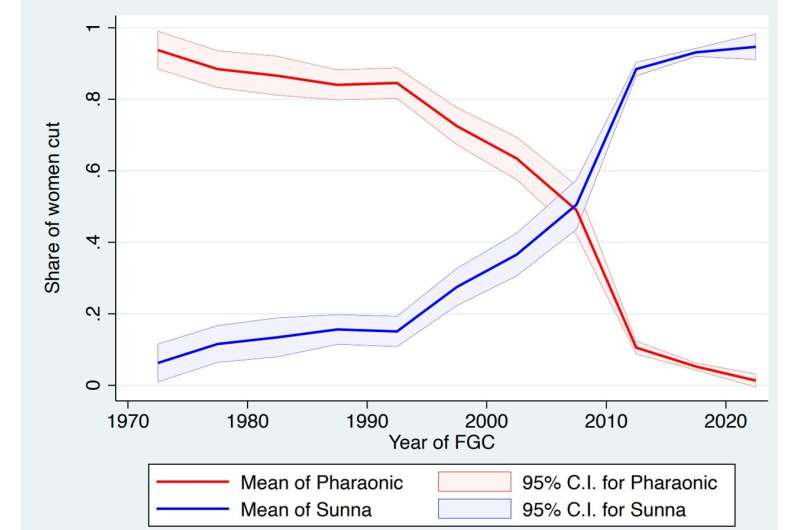This article has been reviewed according to Science X's editorial process and policies. Editors have highlighted the following attributes while ensuring the content's credibility:
fact-checked
trusted source
proofread
Investigating ways to speed up the abolishment of female circumcision

Female circumcision is so harmful that it is quite clear that society would be better off without this kind of practice, but so far progress has been slow.
The economist Eliana La Ferrara is investigating potential ways to speed up the abolishment of this harmful behavior.
There are several types of female circumcision or female genital cutting. La Ferrara is particularly concerned about the two types of circumcision that are most widespread in Africa.
"One is called pharaonic circumcision and can be traced back to ancient Egypt. According to some historians, it originated as a way for slave masters to retain the virginity of their slaves," La Ferrara says.
The second type is called sunna circumcision. It has grown in prevalence in recent decades. "Both types involve major interventions, including removal of the visible part of the clitoris.
However, pharaonic circumcision is far more invasive.
In the article "A Stepping Stone Approach to Understanding Harmful Norms," La Ferrara and co-authors refer to survey data documenting that 63% of women who were pharaonically circumcised in Somalia experienced major sequelae in the form of bleeding, infections, birth pains, pain during intercourse, reduced sensitivity and a number of other complications.
The same figure for the sunna type of circumcision is 11%.
98% circumcised
It is estimated that 200 million women today have been genitally mutilated.
"This is not a marginal phenomenon. On the contrary, it is a major problem in many parts of the world. In Somalia, 98% of women between the ages of 15 and 49 have been circumcised, according to figures from UNICEF," says La Ferrara.
She and her colleagues have collected survey data from 141 different communities in Somalia on the types of FGC practiced and the attitudes of the population.
"The procedure takes place when the girls are between eight and eleven years of age, typically far from any hospital, and with all the attendant risks."
Statistics show that some areas only practice the sunna type of circumcision while other areas are heavily dominated by the pharaonic type. Very few girls end up in the "not circumcised" category.
Eliana La Ferrara's research investigates whether, if we want to change harmful behavior, it would be useful to lay down what she calls a "stepping stone."
"Some parents may not want to go directly from the pharaonic type of circumcision to no circumcision at all for their daughters. In the majority of cases, such a transition is too great. But they may consider going from the pharaonic type of circumcision to the sunna type."
She points out that, if certain modeling assumptions hold, when a sufficient number of girls were to transition to the less harmful option, the path to abolishing the practice would be much easier.
She and her co-authors have developed a comprehensive theory that builds on mechanisms of critical mass in social groups.
This theory predicts that, when a sufficient number of community members have switched to the sunna type of circumcision, some of the remaining practitioners of the pharaonic type will make the "jump" directly from the pharaonic type to no circumcision at all.
Unfortunately, when applying the model to the data, it seems that in the aggregate the conditions for Sunna to act as a stepping stone are not currently satisfied in Somalia.
While a few communities may be transitioning out of FGC, the average community appears to be in an equilibrium where Sunna will be practiced for many more years. This may require interventions other than the natural evolution of the norm, in order to eradicate the practice.
The mothers are the driving force
We often think that it is imams and strict fathers who demand circumcision to control the women in their communities and families.
"The truth is that, based on our survey data, in most cases, it is the mothers who take the initiative and want this for their daughters," she says, adding:
"They do it in good faith that they are helping the girls."
Among other things, mothers assume that girls who are not circumcised will be less integrated in the community.
In collaboration with non-governmental organizations, her research group has tried to influence such attitudes.
"We cannot enter these communities as Western economists and tell them what it is morally right to do. But we can try to change the narrative of female genital mutilation. For example, does it help to tell them that the pharaonic type of circumcision was really about controlling slaves and has nothing to do with religion?"
The statistics she presents is scary. For example, based on Demographic Health Survey data for Sierra Leone, 17 out of 50 women who have been circumcised experienced postnatal death. For non-circumcised women, the figure is 4 out of 50.
'Confirmation ceremony'
In Sierra Leone, information campaigns have focused on the Bondo ritual—a confirmation-like ceremony in which girls are prepared for adulthood. The ritual traditionally ends with circumcision.
"We have held public meetings in the area and informed communities about the possibility of performing the Bondo ritual without the circumcision. In collaboration with the Amazonian Initiative Movement—a non-governmental organization that works to combat female circumcision in Sierra Leone—we emphasize that the symbolic aspects of the Bondo ritual are more important than the surgical procedure itself."
It is also important for mothers that their daughters participate in the Bondo ritual.
"It's a community. The mothers believe that the people their daughters meet during the Bondo ritual will become friends for life, and don't want to deprive them of this opportunity."
It's heading in the right direction.
"We're already seeing a decline of about eight percentage points in the intention to circumcise one's daughters, following the information campaigns."
More information: Report: www.tse-fr.eu/sites/default/fi … 2021/BID/jindani.pdf
Provided by University of Oslo


















